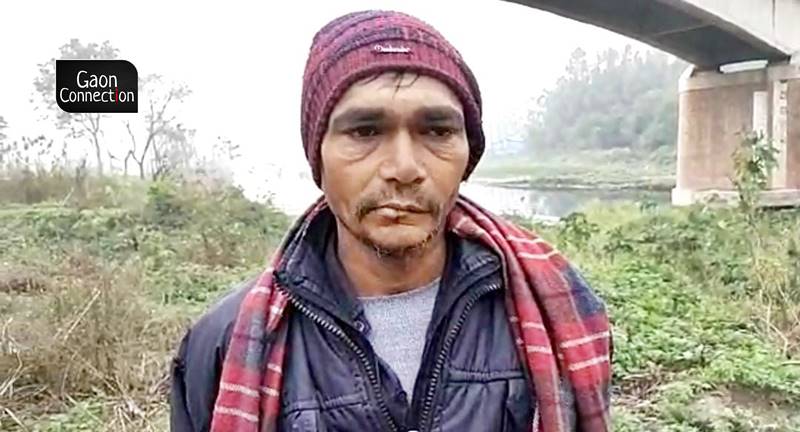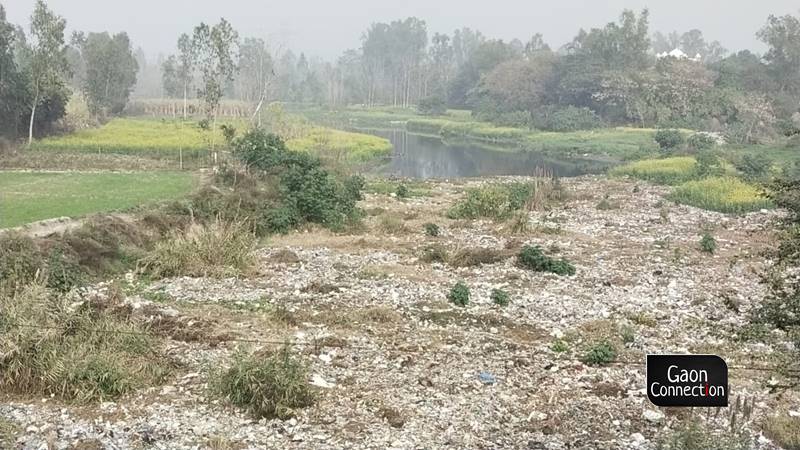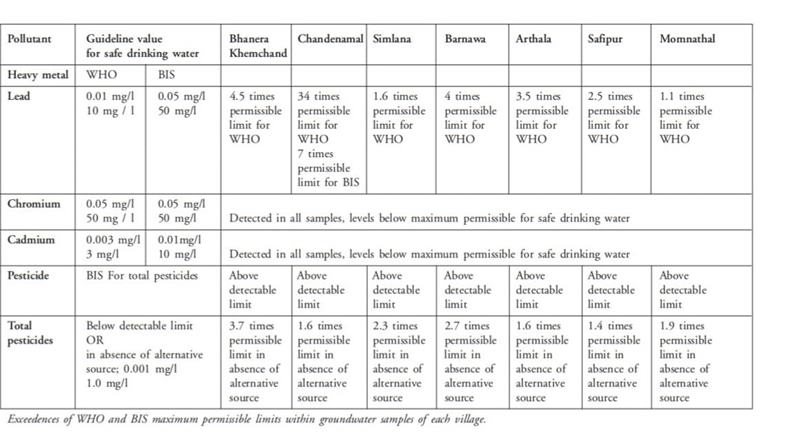It’s election time and fresh promises are being made to clean up the ‘cancer-causing’ Kali River in UP
Kali river, which flows through 80 villages in Muzaffarnagar and Meerut districts of election-bound Uttar Pradesh, has been exposing nearly 250,000 people in these villages to a host of diseases including skin problems and even cancer. Factories dump untreated effluents into the river with impunity and an under-capacity sewage treatment plant is woefully inadequate to deal with the pollution load. Politicians time and again promise to clean up the river, everytime an election comes around. A ground report from The Gaon Postcard series.

Ratanpuri (Muzaffarnagar), Uttar Pradesh
While rivers in India are often considered divine and lifegiving, for Sunil Sharma, a river has been the harbinger of disease and death. “My parents died of cancer and now I am suffering from this disease too,” the 43-year-old resident of Ratanputi village in Muzaffarnagar, told Gaon Connection. In 2015, he lost his father Om Prakash Sharma to stomach cancer and the following year, his mother Kavita Sharma too died of the same disease.
Pointing to the black and turbid river Kali that flowed closeby, he said, “She is the source of our misery. Her polluted waters have given us the disease and villages all along her banks are suffering.” The Kali river smelled so foul that it was difficult to even stand on its bank for more than a couple of minutes.
“There are many factories in the area which dump their effluents directly into the river. A paper factory and many other industries in Meerut and Muzaffarnagar release their toxins into the river. Even animals die within hours of drinking this water,” Sunil added.

Also Read: UP’s villages might vote again on caste and religion. But what they desperately want: clean water.
The Kali river has caused disease and taken lives in at least 80 villages in the districts of Meerut and Muzaffarnagar, claim the villagers.
It is not that the local elected representative is ignorant of the plight of over 250,000 residents in these villages. “I agree that the water quality of the Kali river is far from satisfactory. But this time, I assure you that I will work on cleaning the river,” Vikram Singh Saini, Member of Legislative Assembly (MLA) from Khatauli constituency in which the Ratanpuri village is situated in Muzaffarnagar, told Gaon Connection.
On January 20, when Saini visited his village Manavvarpur, he was chased away by angry villagers.
“The political leaders come to us once every five years. They just talk about the river to draw the crowds. Once that is done and photographs taken, they just go away and never come back to check if things have improved. This time we are fed up,” Monu Kumar Som, a resident of Ratanputi village, told Gaon Connection.

The Curse of Kali
The Kali river originates in the upper Shivalik range of the Himalayas in Uttarakhand and is almost 350 kilometres long. It flows down to the plains of Uttar Pradesh while passing through the districts of Saharanpur, Meerut, Muzaffarnagar and Baghpat. At Baghpat, it meets the Hindon river, and joins the Yamuna near Delhi. Both Kali and Hindon are highly polluted rivers.
“As many as 80 villages in Muzaffarnagar and Meerut are affected by the dirty water of the Kali river. One look at the river is enough to tell you that the water is not fit for consumption,” Raman Tyagi, director of the Meerut-based non-profit NEER Foundation, which works for environment conservation, told Gaon Connection.
“Nobody drinks Kali’s water now but the problem is that the river has also polluted the groundwater reserve in the nearby areas. High incidence of cancer is reported from the villages along the flow of this river,” Tyagi said.

“Our village is hardly fifty metres away from the river. The river has polluted the underground water,” 46-year-old Vijendra Singh, from Ratanputi village, told Gaon Connection. “Almost every household in our village has people who are either suffering from skin infections or stomach problems. Many people have even died of cancer here,” he added.
“Those who can afford to install water purifiers at their homes have done so, the rest of us don’t have a choice,” said Sunil Sharma, a villager.
“People here are poor farmers who do not have the money for expensive screening and long treatment of this disease [cancer]. I got tested only because I had lost my parents to cancer,” he added.
Also Read: ‘It is poison, not water, that comes out of the handpumps’
Reminiscing about his childhood when a coin dropped into the river water was clearly visible through the river’s limpid waters, Sunil is distressed at how that very same crystal clear water has turned black and foul in the last fifteen years.
The chief medical officer (CMO) of Muzaffarnagar, Mahavir Singh Faujdar was unavailable for comment, but he asked his public relations officer (PRO), Shamsher Alam, to respond to Gaon Connection’s query regarding the river.
According to Alam, 571 people out of the 3,462 people screened for diseases in 36 villages along the Kali river in Muzaffarnagar exhibited symptoms that were attributed to the polluted waters.
“We organise medical camps to test people for diseases. But ever since the COVID19 pandemic, these camps have not been held,” Alam told Gaon Connection. “In 2019, a total of 3,462 people were tested for diseases out of which 19 tested positive for cancer, 172 people had respiratory ailments while 380 people were found to be suffering from skin ailments,” he said.
Akash Som, a 22-year-old resident of Ratanpuri village, told Gaon Connection that even animals have died after drinking water from the river.
“Cows, buffaloes and sheep have died due to the dirty water of the river. Just a week ago, we lost a sheep hours after it had drunk from the river,” Som told Gaon Connection. He also reiterated what most other villagers said. “Politicians promise to clean up the river that smells so bad that sometimes it is difficult to even eat one’s meals, but they have done nothing about it.”
Farmlands suffer too as Vijendra Singh, a farmer complained. “The groundwater used for irrigating is so laced with pollutants that the crops die within days of sowing,” he told Gaon Connection.
Villagers along the Kali have little faith in the assurances of the politicians and government officials, as they have heard these empty promises way too many times, every time an election comes around.
Flouting laws with impunity
“We are well aware that the river is highly polluted and are working on it. There are 24 factories that manufacture products like paper, sugar and other chemicals and discharge their waste into the river. We have taken action against these factories as well,” Ankit Singh, area officer of the Uttar Pradesh Pollution Control Board (UPPCB) in Muzaffarnagar, told Gaon Connection.
According to the official, a team has been constituted to assess the toxic effluents in the river and samples have been sent to testing laboratories. “It’s only after getting the results of the tests will we be able to tell what toxic chemicals are present in the water,” Ankit Singh said. He also informed Gaon Connection that “Rs 9,517,500 was collected as fine from these factories during my tenure.”
The reason behind this ‘action’ has been a hoard of court cases in the National Green Tribunal (NGT), the highest environmental court in the country, against the polluted Kali river. However, the river still remains highly contaminated.
Almost three years back, on March 17, 2019, in a landmark judgment, the NGT had ordered closure and registration of cases against 124 industrial units which are polluting the Kali, Krishna and Hindon rivers in six districts of western Uttar Pradesh that include Muzaffarnagar, Shamli, Meerut, Baghpat, Ghaziabad and Gautam Budh Nagar.
The tribunal had also imposed a fine of Rs 50,000,000 on the Uttar Pradesh government as ‘performance guarantee’ to implement the action plan for rejuvenation of the rivers in the western Uttar Pradesh region.

“In view of serious failure of the state of Uttar Pradesh so far and alarming situation of pollution of the river affecting public health, we find it necessary to require furnishing of performance guarantee in the sum of Rs 5 crore to the satisfaction of the Central Pollution Control Board by Uttar Pradesh to the effect that action plan will be implemented within six months. On failure, the amount will be forfeited,” the bench headed by NGT Chairperson Justice Adarsh Kumar Goel had remarked.
But, Kali continues to flow dirty, spreading sickness and death.
Only 40% capacity to treat the effluents
Ankit Singh of the UPPCB pointed out that the sewage waste treatment plant in Muzaffarnagar district was unable to handle the load of untreated effluents.
“The capacity of the existing plant is 32.5 mld [million litres per day], which is way short of what is required (about 82 mld). But, plans to set up three new sewage treatment plants are underway,” Ankit Singh said.
“Two more treatment plants to cleanse the chemical-laden water are also being set up. Once that happens, the water quality of the river will improve considerably,” he said.

Gaon Connection also sought the water quality data from the local Jal Nigam officials in the district but they refused to share it.
‘Award winning work done to ensure clean water’
Meanwhile, Sanjeev Balyan, the Member of Parliament (MP) from Muzaffarnagar told Gaon Connection that ground breaking work has been done to provide clean drinking water in the district. That is why, he said, Muzaffarnagar was awarded as the best district in the north zone in the National Water Awards 2022 announced by the Union Jal Shakti Ministry earlier this month on January 7.
Also Read: Holy cow? Not for the UP farmer, who now spends nights protecting crops against stray cattle attacks
“We have done a lot of work to ensure good water quality in the district. We also bagged the best district award in 2020. It shows our resolve in providing clean drinking water to the population in the district,” declared Balyan who did not comment on the poor water quality of the Kali river.

As per the official data released by the Jal Jeevan Mission, only 27.22 per cent of the rural households in Muzaffarnagar have tap water connections while 26.03 per cent of such households have the facility in Meerut.
Heavy metals in Kali river
Neither the pollution control board nor the Jal Nigam have data on the river water quality. But there are research studies that point towards the toxic chemicals and heavy metals present in the Kali river.
A research paper titled Distribution of heavy metals in water, sediments and fish tissue (Heteropneustis fossilis) in Kali river of western U.P. India, published in the International Journal of Fisheries and Aquatic Studies on February 22, 2016, concluded that the water from the Kali river contained carcinogenic heavy metals like chromium, lead and cadmium (see table).

According to Raman Tyagi of NEER Foundation, high levels of pollutants like cadmium and lead in the water can lead to high incidence of cancer.
Also, as per a research titled Grasping for Breath conducted by the NEER Foundation in 2006, the level of lead in the Kali river in Muzaffarnagar was found to be many times higher than the maximum permissible levels by the World Health Organization (WHO). At one location in Chandenamal formerly in the Muzaffarnagar district (now in Shamli district), the level of lead was found to be 34 times higher than the WHO’s permissible limit (see table).

Anil Kumar, a Muzaffarnagar-based political leader from the Samajwadi Party told Gaon Connection, the Kali river matter could influence how the rural population voted.
“They (BJP leaders) have done nothing to solve the crisis of the dirty water here. The people are well aware of it. When voted to power, I will ensure that this menace of dirty water in the Kali river is successfully resolved,” he promised.
Written by Pratyaksh Srivastava

